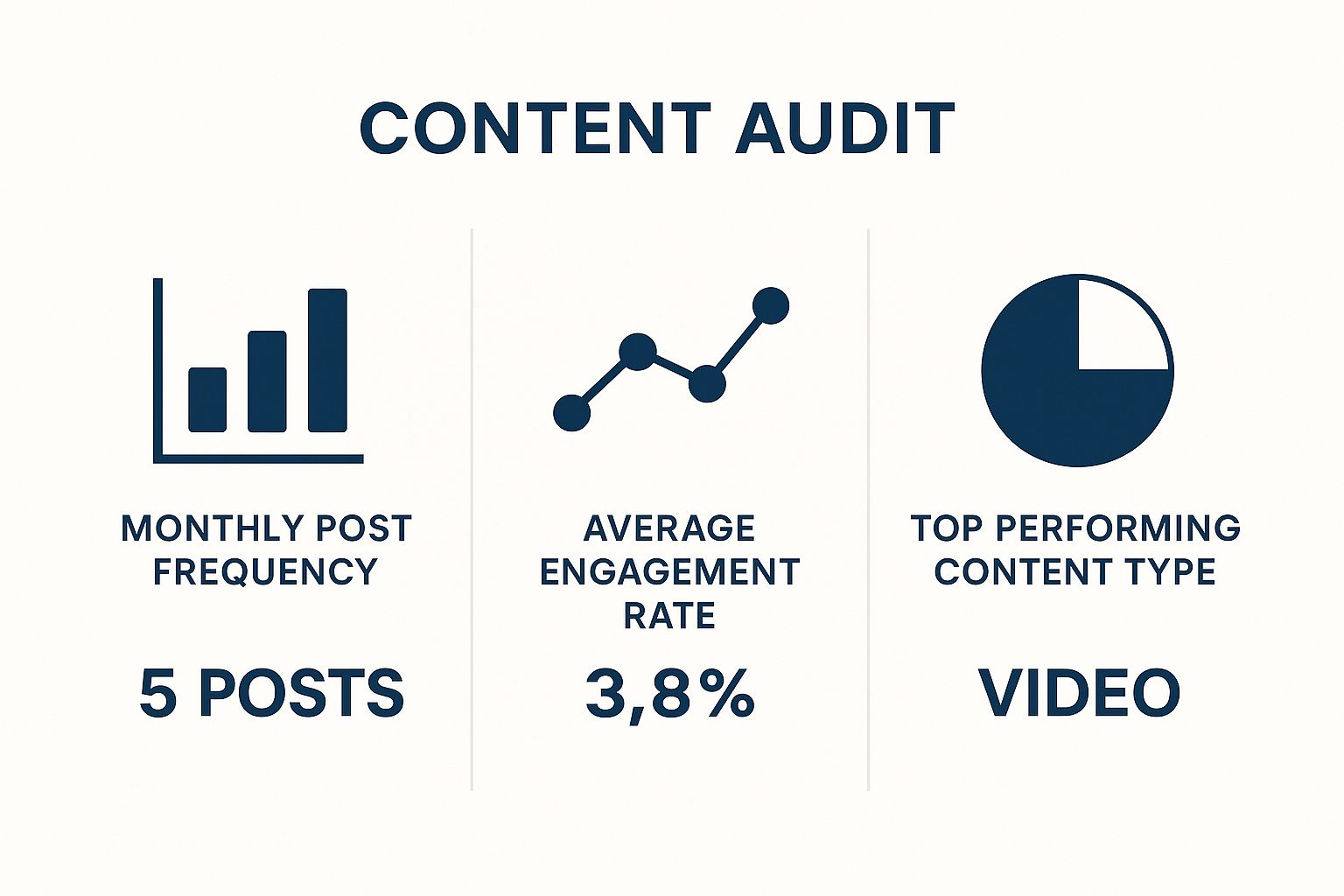Navigating Today’s Social Media Landscape
The social media world is in constant flux. Trends come and go at lightning speed. This dynamic environment demands a solid social media content strategy to rise above the noise and truly connect with your audience. This involves understanding not only what to post, but also where, when, and why.
Understanding Audience Behavior
Audience behavior is the bedrock of effective social media. New to online content? Platforms like WordPress provide tools and resources for content creation and distribution. But understanding your audience extends beyond basic demographics. It requires a deeper dive into their online habits, preferred content, and the platforms they use most. For instance, a brand targeting Gen Z might lean towards TikTok and Instagram, emphasizing short-form videos. A B2B company, conversely, might find LinkedIn more suitable for in-depth articles and industry analysis.
Emerging Platforms and Trends
The social media landscape is ever-expanding, with new platforms and features appearing regularly. Staying informed on popular platforms and evolving user behavior is critical. Keeping up with trends, like the rise of short-form video and the increasing importance of authenticity, empowers brands to create resonant content. This also requires adapting your social media content strategy to effectively incorporate these trends.
As of February 2025, a significant 63.9% of the global population actively engages with social media, averaging 2 hours and 21 minutes daily on these platforms. This emphasizes the need for a well-defined social media content strategy to reach this vast, engaged audience. Learn more about social media usage statistics. Brands embracing agile content experimentation, using tools like ChatGPT and Midjourney for ideation and production, are seeing impressive results. This trend highlights the growing demand for personalized, real-time content, particularly on video-focused platforms like TikTok and YouTube Shorts.
Breaking Through the Noise
With the sheer volume of content competing for attention, creating a standout social media content strategy is paramount. This requires developing high-quality, engaging content that delivers value to your audience. It also necessitates understanding the unique characteristics of each platform and tailoring your content accordingly. Experimenting with different formats, such as live videos, interactive polls, or user-generated content, can reveal what best resonates with your audience. Continuously analyzing performance and adapting your strategy ensures effectiveness in this ever-changing landscape.
Crafting Social Goals That Actually Matter
Too often, brands focus on vanity metrics like follows, shares, and likes. While these numbers might look impressive, they don’t always translate into meaningful business results. A strong social media content strategy prioritizes goals aligned with real business outcomes. This means focusing on objectives that drive demonstrable value, such as increased revenue, stronger customer loyalty, or improved brand perception.
Aligning Social Media with Business Outcomes
Successful brands view social media as an integral part of their overall marketing strategy, not a separate activity. For example, if lead generation is a company’s primary goal, their social media content should focus on driving traffic to landing pages and capturing contact information. If the objective is to boost brand awareness, the strategy might emphasize reach and engagement on platforms where their target audience is most active.
Identifying Key Metrics
Selecting the right metrics is crucial for measuring progress. While vanity metrics can offer some insights, they shouldn’t be the primary focus. Instead, prioritize metrics directly linked to business objectives. This could include website traffic from social media, conversion rates from social media leads, or brand sentiment changes measured through social listening.
Consider the increasing importance of platforms like Threads. Threads has quickly become a popular platform, driven by its real-time news and community focus. Marketers report that 80% prioritize social media for brand exposure, 73% for traffic growth, and 65% for lead generation. Find more detailed statistics here.
You might be interested in: How to master sitemaps
Setting Measurable Objectives
Vague goals produce vague results. To be most effective, set SMART goals: Specific, Measurable, Achievable, Relevant, and Time-bound. For instance, instead of aiming to “increase brand awareness,” a SMART goal might be to “increase website traffic from social media by 15% within the next quarter.” This provides a clear, measurable target and a timeframe.
The following table illustrates how to align business goals with social media objectives and key metrics:
A table illustrating common social media goals and their corresponding metrics can be helpful in guiding your strategy.
Social Media Goals and Corresponding Metrics: A breakdown of common social media goals and the specific metrics businesses should track to measure success
| Business Goal | Social Media Objective | Key Metrics to Track | Measurement Timeframe |
|---|---|---|---|
| Increase Brand Awareness | Increase reach and engagement on target platforms | Impressions, reach, engagement rate, share of voice | Monthly/Quarterly |
| Drive Website Traffic | Drive traffic from social media to website | Website clicks, referral traffic from social media | Weekly/Monthly |
| Generate Leads | Capture contact information through social media channels | Lead form submissions, email sign-ups, content downloads | Weekly/Monthly |
| Improve Customer Service | Respond to customer inquiries and resolve issues on social media | Response time, customer satisfaction score, issue resolution rate | Daily/Weekly |
| Drive Sales | Promote products/services and encourage purchases through social media | Conversion rate, sales generated from social media, click-through rate on product links | Weekly/Monthly |
This table provides a framework for aligning your overall business goals with specific social media objectives and measurable metrics. By tracking these metrics over defined timeframes, you can effectively assess the impact of your social media efforts.
Demonstrating Value to Stakeholders
Leadership teams want to see how social media contributes to the bottom line. By connecting your social media content strategy to measurable business objectives, you can demonstrate the value of your work and secure support for future initiatives. This involves regular reporting on key metrics and showing the impact of social media on overall business goals. Understanding current career paths and available opportunities, including roles in entry level social media marketing jobs, can also provide valuable context for your social media strategy.
Finding Your Audience Where They Actually Live
Many brands mistakenly try to maintain a presence on every social media platform. This spreads their resources too thin, preventing them from truly connecting with their audience. A strong social media content strategy requires understanding not only who your audience is, but also where they spend their time online.
This means identifying the platforms your specific audience segments use most actively and tailoring your content accordingly. This targeted approach maximizes your impact and avoids wasting resources on platforms where your audience isn’t present.
Creating Detailed Audience Personas
Effective audience personas go beyond basic demographics. They delve into your audience’s behaviors, motivations, and online habits. For example, a Gen Z audience might prefer TikTok and Instagram, drawn to short-form video content and interactive features like Stories and Reels.
A B2B audience, however, might favor LinkedIn for industry news, professional networking, and in-depth articles. Tailor your content format and platform choices to each segment’s preferences. Learn more in our article about How to master sitemaps.
Conducting Competitive Audience Analysis
Analyzing your competitors’ social media presence offers valuable insights into their audience targeting strategies. Identify where your competitors are succeeding and where they are falling short. This helps you uncover untapped opportunities and refine your own approach.
Examine the platforms they prioritize, the type of content they share, and their engagement levels. This competitive analysis informs your platform decisions, allowing you to focus on the channels where your target audience is most receptive.
Platform-Specific ROI
Different platforms offer varying return on investment (ROI) depending on your business model and target audience. Visually-driven businesses might find Instagram or Pinterest highly effective for showcasing products and driving sales. Businesses offering professional services, conversely, might see better results on LinkedIn.
Evaluate the ROI of each platform based on your specific goals and audience engagement. This strategic approach ensures you’re investing your resources in the platforms that deliver the greatest value.
The following data chart visualizes hypothetical audience distribution across different social media platforms for a specific brand.
As the data chart shows, this hypothetical brand sees the largest percentage of its target audience on Instagram and Facebook, suggesting these should be prioritized.
To further illustrate platform choices, let’s look at a comparison of several popular options. The following table, “Social Media Platform Comparison,” analyzes major social platforms, their audience demographics, content types, and strategic advantages.
| Platform | Primary Demographics | Content Formats | Engagement Style | Best For |
|---|---|---|---|---|
| 18-34 years old, skews slightly female | Images, short videos, stories, reels | Visually-driven, community-focused | Brands with strong visual content, influencers, e-commerce | |
| 25-54 years old, relatively even gender split | Text, images, videos, live streams, groups | Diverse, community-based | Businesses seeking broad reach, community building, advertising | |
| TikTok | 16-24 years old, skews slightly female | Short-form videos, trending challenges, music-focused | Entertainment-focused, high virality potential | Brands targeting Gen Z, creative content, influencer marketing |
| 25-54 years old, professional audience | Articles, long-form content, professional networking | Professional, industry-focused | B2B marketing, professional networking, thought leadership | |
| 25-49 years old, relatively even gender split | Short-form text, news updates, real-time conversations | News-driven, public discourse | Businesses seeking real-time engagement, news dissemination, public relations |
This table summarizes the key features of each platform, making it easier to align your strategy with your specific audience and goals. Choosing the right platform is crucial for effective social media marketing.
Creating Content That Captivates and Converts
Engaging social media content requires a deep understanding of your audience’s psychology. Knowing what motivates them to interact, share, and ultimately become customers is key. This section explores how successful brands craft a social media content strategy that resonates with their target audience and delivers measurable results.
Balancing Content Types for Maximum Impact
A winning social media content strategy incorporates a balanced blend of created content, curated content, and user-generated content (UGC). Created content, such as blog posts, videos, and infographics, is original material produced by your brand. Curated content involves sharing relevant content from other sources, positioning your brand as an industry authority. Finally, UGC showcases your audience’s experiences and perspectives, adding authenticity and social proof. Finding the right balance among these content types is essential for maximizing impact and managing resources effectively.
Content Ideation Frameworks
Effective content ideation begins with understanding your audience’s needs and interests. Social listening, competitive analysis, and staying abreast of emerging trends can fuel your content creation process. Monitoring relevant hashtags and keywords, for instance, can reveal trending topics within your target audience. Competitive analysis can uncover content gaps and opportunities to differentiate your brand. By leveraging these insights, you can develop a content strategy that consistently delivers valuable and engaging material.
Platform-Specific Optimization and Brand Voice
Tailoring content formats to each platform is crucial for optimal performance. Instagram thrives on visually appealing content, while LinkedIn favors professional, long-form articles. Maintaining a consistent brand voice across all platforms, however, is equally important for reinforcing brand identity and building trust. It’s a delicate balance between adapting to platform-specific best practices and ensuring a cohesive brand experience.
Scaling Content Production While Maintaining Authenticity
With social media ad spending projected to reach $255.8 billion by 2028, brands face increasing pressure to scale content production. The rise of hyperscale platforms like Meta, projected to surpass linear TV ad revenue by 2025, further underscores this need. Find more detailed statistics here. This growth demands efficient scaling strategies without sacrificing quality or authenticity. Leading brands achieve this through automation tools, streamlined workflows, and strategic partnerships with content creators.
In this dynamic landscape, continuous experimentation is essential. As users prioritize authenticity, brands must remain genuine and relatable while scaling their efforts. This may involve incorporating more UGC, embracing imperfections, and showcasing the human side of their brand.
Measuring Content Performance and Adapting Your Strategy
Analyzing content performance and making data-driven adjustments are vital for continuous improvement. Tracking key metrics like engagement rates, reach, and conversions provides valuable insights. This data-driven approach allows you to refine your strategy over time, ensuring its effectiveness and alignment with your business goals. Regular content audits can help identify outdated or underperforming content, creating opportunities for optimization and improvement. This iterative process of analyzing, adapting, and refining is crucial for maximizing the impact of your social media endeavors.
Building a Content Calendar That Actually Works
Many social media content strategies fail because their content calendars are treated as rigid schedules instead of adaptable tools. Successful brands understand that a balance between planned content and the flexibility to adapt to current trends and opportunities is key. This means structuring your calendar around your audience’s behavior, not just predetermined posting times.
Structuring Your Calendar Around Audience Behavior
Forget strict posting schedules. Instead, focus on when your audience is most engaged. Tools like Sprout Social’s Optimal Send Times can help you identify these periods for maximum impact. This data-driven approach ensures your content reaches the right people at the optimal time.
Incorporating Trending Topics
A consistent content strategy is essential, but staying relevant means incorporating trending topics. This doesn’t mean abandoning your plan. Think of trends as chances to create timely, engaging content that supports your core message. For instance, if a relevant hashtag is trending, craft a post connecting it to your brand or industry.
Optimizing Workflow and Maintaining Quality
A smooth workflow is essential for efficient content creation. This means minimizing approval bottlenecks while upholding quality. Tools that facilitate collaborative editing and scheduling can significantly boost efficiency. Clear brand guidelines also ensure consistent messaging and voice across all content. Check out our guide on How to master sitemaps.
Balancing Platform-Specific Needs and Resources
Different platforms have unique content requirements. Instagram, for example, is visually driven, while LinkedIn prefers professional, long-form content. Your content calendar should reflect these differences. It’s also crucial to balance platform-specific needs with your resources. Prioritize the platforms offering the highest ROI for your business and allocate resources accordingly. This may mean concentrating on a few key platforms instead of trying to maintain a presence everywhere. This focused approach maximizes your impact within your resource limitations.
Maximizing Reach Without Draining Your Budget
Even the most engaging content can fail to gain traction without a well-defined distribution strategy. This involves understanding how to adapt to algorithm updates and declining organic reach to ensure your target audience sees your content. Optimizing distribution is key to any successful social media content strategy. This section explores practical tactics for expanding your reach efficiently.
Identifying Optimal Posting Windows
Posting at times deemed generally effective is rarely a successful tactic. Instead, concentrate on pinpointing the optimal posting windows for your specific audience. This requires analyzing your social media analytics to determine when your followers are most engaged.
For instance, if your target audience is primarily located on the East Coast, scheduling posts during their morning commute or lunch break might yield better results. Social media management tools, such as Buffer, often offer features like “optimal send times” to automate this process.
Leveraging Cross-Promotion Strategies
Cross-promotion is a powerful method for increasing your content’s visibility and utilizing platform algorithms. This involves sharing your content across different social media channels. You could, for example, share a preview of your YouTube video on Instagram Stories, including a swipe-up link to the full video.
Partnering with other brands or influencers is another effective way to connect with new audiences and expand your reach.
Balancing Organic and Paid Strategies
Declining organic reach is a common issue on many platforms. However, this doesn’t mean abandoning organic strategies entirely. Instead, strive for a balance between organic content and paid social media advertising.
Organic content fosters community and encourages genuine interaction, while paid advertising amplifies your message and targets specific demographics. A dual approach maximizes your impact. For example, boosting a well-performing organic post can help it reach a broader segment of your target audience.
Analyzing Successful Campaigns: Engagement-to-Resource Ratio
Critically evaluating which distribution tactics offer the best return on investment is essential for refining your social media content strategy. This means analyzing successful campaigns across various industries and platforms.
Look for common threads in their distribution strategies. Did these successful campaigns prioritize organic content, paid advertising, or a blend of both? Which platforms generated the highest engagement-to-resource ratio? By studying successful campaigns, you can identify best practices and tailor them to your own strategy. This data-driven approach ensures you’re maximizing reach without wasting valuable resources.
Measuring What Matters and Evolving Your Strategy
Beyond simple metrics like followers and likes, true social media success hinges on its impact on your core business objectives. This means understanding which metrics genuinely drive your business forward and using them to constantly refine your social media content strategy. It’s about linking social media performance to tangible results, not just chasing vanity metrics.
Establishing Meaningful Benchmarks
Instead of relying on generic industry averages, create benchmarks tailored to your unique goals. For example, if you aim to boost website traffic, your benchmark could be a specific percentage increase in referral traffic from social media. This focused approach offers a more accurate measure of success than simply comparing your performance to industry standards. It’s about what delivers results for your business, not what works for everyone else.
Gathering Actionable Insights
Data is valuable, but excessive data can be overwhelming. Concentrate on gathering actionable insights that directly inform your strategy. This could involve using social listening tools like Brand24 to understand audience sentiment toward your brand, or analyzing website traffic data through a platform like Google Analytics to identify which social platforms drive the most conversions. It’s about using data strategically to make informed decisions, not just accumulating it.
The Power of Content Audits
Regular content audits are essential for evaluating the effectiveness of your current content. This involves analyzing past performance to pinpoint what resonated with your audience and what didn’t. A content audit might reveal, for example, that video content consistently outperforms text-based posts, prompting you to prioritize video production in your strategy. This data-driven approach ensures you are continuously learning and adapting.
Implementing Testing Cycles
A static social media strategy quickly becomes stagnant. Continuous testing is essential to stay ahead. This could involve experimenting with different content formats, posting schedules, or targeting parameters. This iterative process of A/B testing helps optimize your strategy by identifying what resonates most effectively with your audience. It’s about embracing experimentation and constant improvement.
Translating Insights into Strategic Refinements
The insights gleaned from measurement and testing should inform strategic adjustments. If a specific type of content consistently underperforms, for example, consider revising your approach or reallocating resources to more effective formats. This ongoing cycle of analysis and refinement is vital for maximizing your impact and keeping pace with emerging trends. It’s about adapting and evolving, not clinging to outdated methods.
Demonstrating Social Media’s Value
By connecting social media performance to business outcomes, you can demonstrate its value to stakeholders. This involves regularly reporting on key performance indicators (KPIs) and showcasing the impact of your social media activities on overall business goals. For example, if your social media strategy generates a significant increase in leads, this tangible result clearly demonstrates the value of your work. This clear demonstration of ROI justifies continued investment in your social media efforts.
Ready to connect with the right influencers for your brand and elevate your social media strategy? REACH Influencers provides a robust platform to discover and collaborate with micro and nano influencers who perfectly align with your target audience. Start building impactful influencer campaigns with REACH Influencers today!






